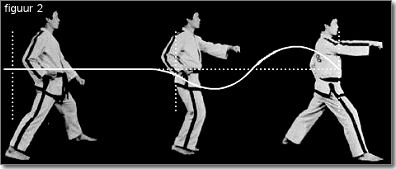Sine Wave Motions Sine wave motion is a movement unique to original Taekwon-do to create maximum force in every moment according to the theory of power . In almost every moment this sinewave is utilized. Sinewave is natural and simple, and often I heard an instructor say: "Simple and natural = beautiful" . There are some key benefits to using sine wave that are linked to the training secrets of Taekwon-Do. Moving our center of mass in the motion of a sine wave requires us to keep our arms and legs bent while the body is in motion. To keep the arms and legs bent during motion we need to be relaxed. Relaxing the body adds speed to a technique because we are not all tensed up with one part of the body working against another. Small increases in speed produces large increases the power of a technique. How much of a sine wave should there be in a Taekwon-Do technique? The displacement that the center of mass moves from the zero line to get to the bottom and top of the sine wave this is called the amplitude. Using too much sine wave defeats a technique because all the body's energy and motion would be dedicated to moving along the sine wave rather than accelerating into the target -- (Harry Burke)
|
Connected Motions |
| The basics of sinewave is down-up-down, in other words there is always a downward motion first, followed by an upward motion, and ending in a downward motion. There are however variations on sinewave, which are related to the motion, combination and speed of the techniques used. In traditional Taekwon-do, the fundamental exercises and the tuls there are five different motions:
Normal motion (1-1-1) Connecting motion (2-1-1) Full sinewave Only in normal motion, continuous motion and slow motion there is a full sinewave (down-up-down). |


